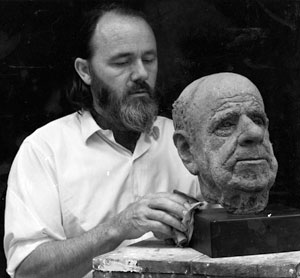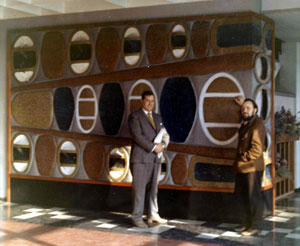Inspirations and mentors

Artist with 'Portrait of an Old Man'
The abiding influence and inspiration for Osborne's art was 'the form', and understanding this is the bedrock to understanding his work. Osborne was inspired by the cream of previous figurative artists, and pointed to Michelangelo and Rodin, in particular. However, there are also many pervasive influences from Indian and African sculpture that are just as important to his work.
Osborne's military service in India came at a period that is often critical to a young person's development, and gave him direct access to Indian temples, and allowed him to experience the influence of natural form on art, which reinforced his early leanings towards naturalism. The particularly rounded, even voluptuous, style of Indian figurative art was a powerful influence both on his nudes and non-figurative "mindforms". An additional indirect influence of this period spent in India was that it insulated Osborne from the growing influences of modernism and abstractionism in European art, which was seeping into the art colleges of Britain during the 1940s.
While at the Royal College of Art, Osborne's interest in the role of natural form in art developed through contact with two giants of then contemporary sculpture: Frank Dobson and Jacob Epstein. Dobson was Professor of Sculpture at the RCA, whose own sculpture had evolved into a more simplified realistic style, displaying some of the same fascinations with curve as were apparent in Osborne's work. Both men's work continued the traditions of classical realism, and those of non-western art, that were temporarily overshadowed by the emergence of post-modernism and conceptual art – movements for which Osborne had little time.

'The Wall' with Artist
However, Osborne's ideas were perhaps more influenced by the mentorship of Jacob Epstein. Although Osborne and Epstein differed in many ways, they shared a passion for the depiction of form, and both drew heavily on non-western influences in their work. The starkness of Epstein's forms would find reflection in Osborne's views, who would often say: "It's not what you put in, but what you leave out, that matters". The fact that a sculptor of such repute and stature as Epstein found the young Osborne to be a kindred spirit and talent sustained Osborne's own developing views of art.
Following his London years, Osborne's work continued to draw from his love of form, and this was expressed through a variety of different sculptural media, including figurative work focused on the human form, which encompassed a number of portraits of his daughter, and a series of non-figurative works that drew on the importance of natural form. In the later phase of his career, Osborne turned to the animal world for inspiration, carving and modelling, sometimes in a naturalistic manner, and sometimes in a stylised non-western manner; reflecting both his early childhood models and influences from his time in India. These animal forms remained an abiding inspiration for the rest of his career.